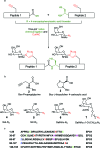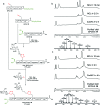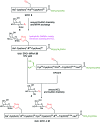A synthetic approach to 'click' neoglycoprotein analogues of EPO employing one-pot native chemical ligation and CuAAC chemistry
- PMID: 30774876
- PMCID: PMC6345360
- DOI: 10.1039/c8sc03409e
A synthetic approach to 'click' neoglycoprotein analogues of EPO employing one-pot native chemical ligation and CuAAC chemistry
Abstract
The clinical significance of batch-wise variability on the pharmacokinetics and potency of commercial erythropoietin (EPO), prepared recombinantly as a heterogeneous mixture of glycoforms, necessitates the development of synthetic strategies to afford homogenous EPO formulations. Herein we present a previously unexplored and divergent route towards 'click' neoglycoprotein analogues of EPO, employing one-pot native chemical ligation (NCL) of alkynylated peptides and copper-catalysed azide-alkyne cycloaddition (CuAAC) with azido monosaccharides. By design, our synthetic platform permits glycosylation at virtually any stage, providing flexibility for the synthesis of various glycoforms for biological analysis. Insights obtained from attempted folding of our 'click' neoglycoprotein EPO analogue, bearing four different neutral sugar moieties, highlight the important role played by the charged oligosaccharides present in native EPO glycoproteins.
Figures








Similar articles
-
Chemical synthesis of erythropoietin glycoforms for insights into the relationship between glycosylation pattern and bioactivity.Sci Adv. 2016 Jan 15;2(1):e1500678. doi: 10.1126/sciadv.1500678. eCollection 2016 Jan. Sci Adv. 2016. PMID: 26824070 Free PMC article.
-
'Click' glycosylation of peptides through cysteine propargylation and CuAAC.Bioorg Med Chem. 2014 Dec 1;22(23):6672-6683. doi: 10.1016/j.bmc.2014.09.056. Epub 2014 Oct 27. Bioorg Med Chem. 2014. PMID: 25457125
-
Recent Progress in the Synthesis of Homogeneous Erythropoietin (EPO) Glycoforms.Chembiochem. 2020 Dec 1;21(23):3301-3312. doi: 10.1002/cbic.202000347. Epub 2020 Jul 30. Chembiochem. 2020. PMID: 33210450 Review.
-
Peptide conjugation via CuAAC 'click' chemistry.Molecules. 2013 Oct 24;18(11):13148-74. doi: 10.3390/molecules181113148. Molecules. 2013. PMID: 24284482 Free PMC article.
-
CuAAC ensembled 1,2,3-triazole linked nanogels for targeted drug delivery: a review.RSC Adv. 2023 Jan 18;13(5):2912-2936. doi: 10.1039/d2ra05592a. eCollection 2023 Jan 18. RSC Adv. 2023. PMID: 36756399 Free PMC article. Review.
Cited by
-
Recent Advances in the Chemical Biology of N-Glycans.Molecules. 2021 Feb 16;26(4):1040. doi: 10.3390/molecules26041040. Molecules. 2021. PMID: 33669465 Free PMC article. Review.
-
Chemical and Enzymatic Synthesis of Sialylated Glycoforms of Human Erythropoietin.Angew Chem Int Ed Engl. 2021 Dec 1;60(49):25922-25932. doi: 10.1002/anie.202110013. Epub 2021 Nov 2. Angew Chem Int Ed Engl. 2021. PMID: 34523784 Free PMC article.
-
Expedient Azide-Alkyne Huisgen Cycloaddition Catalyzed by a Combination of VOSO4 with Cu(0) in Aqueous Media.ACS Org Inorg Au. 2023 Dec 19;4(2):235-240. doi: 10.1021/acsorginorgau.3c00059. eCollection 2024 Apr 3. ACS Org Inorg Au. 2023. PMID: 38585512 Free PMC article.
-
Advances in the chemical synthesis of human proteoforms.Sci China Life Sci. 2025 Sep;68(9):2515-2549. doi: 10.1007/s11427-024-2860-5. Epub 2025 Apr 8. Sci China Life Sci. 2025. PMID: 40210795 Review.
References
-
- Graber S. E., Krantz S. Annu. Rev. Med. 1978;29:51–66. - PubMed
-
- Eschbach J. W., Egrie J. C., Downing M. R., Browne J. K., Adamson J. W. N. Engl. J. Med. 1987;316:73–78. - PubMed
-
- Bohlius J., Wilson J., Seidenfeld J., Piper M., Schwarzer G., Sandercock J., Trelle S., Weingart O., Bayliss S., Djulbegovic B. J. Natl. Cancer Inst. 2006;98:708–714. - PubMed
-
- Recny M. A., Scoble H., Kim Y. J. Biol. Chem. 1987;262:17156–17163. - PubMed
-
- Sasaki H., Bothner B., Dell A., Fukuda M. J. Biol. Chem. 1987;262:12059–12076. - PubMed
LinkOut - more resources
Full Text Sources
Research Materials
Miscellaneous

